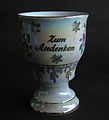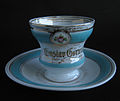Collecting cup
The tradition of the collector's cup goes back to the Biedermeier period . In the early 19th century, porcelain became cheaper, and the custom of collecting cups or giving them away on special occasions developed in middle-class circles, also as a gift of friendship and often with a personal dedication. As souvenirs , collectors' cups and other porcelain knick- knacks were already widespread in the 19th century.
Cups as showpieces
The souvenir cups were not intended for everyday use, but were displayed as representative items in the showcases of the Biedermeier living rooms. Individual decors and lettering can be ordered from almost all manufacturers. In contrast to today, the face of the cup was exactly opposite the handle, so that it did not interfere with the painting and lettering.
The view cups with a picture of a landscape or a city were particularly popular in the Biedermeier period. In addition, there were all kinds of other representations on the cups, such as maps, relief portraits, house facades, flower pictures, rose petals, birds or well-known buildings. Cups with sayings were also widespread .
Crockery for the coffee table
The coffee or tea table became the center of family life in the Biedermeier period. Particular attention was paid to the dishes. In addition to the cups, the coffee service consisted of various jugs and a sugar bowl. Cake plates were not part of it at first, as no cake was served with tea or coffee.
The manufacturers reacted to the increasing desire to collect tableware with increasingly extensive range of models. The porcelain manufacturer Fürstenberg for example, developed during the 19th and 20th centuries over a hundred different cup shapes and corresponding number of decors. In 1860 the available inventory comprised 91 models, and in 1926 around 200 collection cups, some of which were decorated with high quality, and the smaller mocha cups that appeared around 1900 were offered.
The heyday of the collection cups in the 20th century lasted until the 1930s. As before, they were only used on special occasions and were popular gifts for trousseau or birthdays. After the Second World War , the tradition lived on for two decades until it finally lost its importance in the 1970s. A collector's market then developed for older pieces in the 1990s. At the same time, artists created new single place-setting collections adapted to current tastes in terms of shape and decor, the success of which, however, is determined not least by the desire of young buyers for dishwasher-safe tableware.
Selection of individual cups
literature
- Renate Möller: Porcelain from Meissen to the present day . Deutscher Kunstverlag, Munich / Berlin 1995, ISBN 3-422-06153-3 .
- Georg Himmelträger : Art of the Biedermeier period 1815-1835 . Prestel-Verlag, Munich 1988, ISBN 3-7913-0885-8 .
- Ulrich Pietsch: The collector's cup in the 18th and 19th centuries . Weltkunst magazine, Volume 60 (1990) No. 8, pp. 1218–1220.




